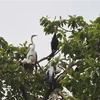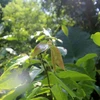Two new Castanopsis (chinquapin) species have recently been discovered in the Xuan Son National Park in the northern midland province of Phu Tho, bringing the total number of the species of the genus found in the park to eight.
Castanopsis grandicicatricata was found 459 metres above sea level on the park’s lime stone mountain. It has a thick papery leafy texture, cupules 6 – 7 centimetres in diameter, and a scar covering two-thirds of a nut, said Dr Vuong Duy Hung from the Vietnam Forestry University’s Faculty of Forest Resources and Environment Management.
About 832 metres above sea level, Castanopsis multiporcata has 5 – 8 centimetre-long abaxial leaf blades, a firm papery leafy texture, 6 - 10 pairs of secondary veins, petioles 0.3 - 0.7 centimetres long, cupules 2 - 2.5 centimetre in diameter, and a concave scar.
From 2013 to 2014, scientists uncovered two species of the ginger family (Zingiberaceae), namely Alpinia pholyantha and Amomum putrescens, in the park. Both were recorded for the first time in Vietnam.
They also found a new species of Aspidistra scientifically named after the reserve, Aspidistra xuansonensis.
Surveys over recent years revealed various new flora species in the park, adding to the number of recorded species here from 726 in 2002 to the current 1,252.
The Xuan Son National Park has an area of 15,048 hectares and a buffer zone of 18,639 hectares. It is spread across the communes of Xuan Son, Kim Thuong, Xuan Dai, Dong Son, Tan Son, and Lai Dong.
It is also home to more than 360 fauna species, including 46 listed in Vietnam’s Red Book and 18 others in the World Red Book. Some are typical to the northwest region such as langurs, gibbons, civets, squirrels, bears, leopards, pheasants, and peacock pheasants.-VNA
Castanopsis grandicicatricata was found 459 metres above sea level on the park’s lime stone mountain. It has a thick papery leafy texture, cupules 6 – 7 centimetres in diameter, and a scar covering two-thirds of a nut, said Dr Vuong Duy Hung from the Vietnam Forestry University’s Faculty of Forest Resources and Environment Management.
About 832 metres above sea level, Castanopsis multiporcata has 5 – 8 centimetre-long abaxial leaf blades, a firm papery leafy texture, 6 - 10 pairs of secondary veins, petioles 0.3 - 0.7 centimetres long, cupules 2 - 2.5 centimetre in diameter, and a concave scar.
From 2013 to 2014, scientists uncovered two species of the ginger family (Zingiberaceae), namely Alpinia pholyantha and Amomum putrescens, in the park. Both were recorded for the first time in Vietnam.
They also found a new species of Aspidistra scientifically named after the reserve, Aspidistra xuansonensis.
Surveys over recent years revealed various new flora species in the park, adding to the number of recorded species here from 726 in 2002 to the current 1,252.
The Xuan Son National Park has an area of 15,048 hectares and a buffer zone of 18,639 hectares. It is spread across the communes of Xuan Son, Kim Thuong, Xuan Dai, Dong Son, Tan Son, and Lai Dong.
It is also home to more than 360 fauna species, including 46 listed in Vietnam’s Red Book and 18 others in the World Red Book. Some are typical to the northwest region such as langurs, gibbons, civets, squirrels, bears, leopards, pheasants, and peacock pheasants.-VNA



















